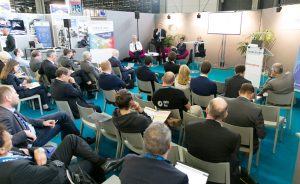
A positive show, says Eurosatory General Manager
As Eurosatory is about to closing we meet the exhibition General Manager, Patrick Colas des Francs, in his office which dominates part of the covered area. While the equipment is prepared for being moved out, the vehicles line up to reach the parking and stands are taken down, it is time to look at statistics and draw the first conclusions. “If you look at the numbers, 1,802 exhibitors with an increase of over 14%, this puts Eurosatory as the benchmark for defence exhibitions, ahead of our competitors DSEI and IDEX, which is confirmed by the number of delegations, 227 from 94 nations, for 760 individuals overall.” Eurosatory is attracting new exhibitors from various countries: “I also see countries which are part of the Commonwealth and used to exhibit at DSEI, which are now coming to Paris: as an example I can mention Australia, which increased from three to 46 exhibitors since 2016. I met them this morning and they were very happy to have crossed the Channel.”

In terms of visitors the increase was not considerable, with just a +0.7% bringing the total number to 57,056, railway strikes having not helped to reach the exhibition area on Tuesday and Wednesday. “All exhibitors however told me that we have increased the quality of visitors, first of all because there are many more foreign visitors, their percent stepping up from 40 to 50%. On the other hand visitors tell me that they met the right people, and this means to me a professionalization of the exhibition, as well as a further internationalisation.”

“If I could choose a word to sum up Eurosatory 2018 I would choose “Innovation”: my teams go around the aisles to chase what is totally new or what has been upgraded, and although data are not yet confirmed, we increased the number of new items from 450 to nearly 600.” These were brought to Paris not only by major defence groups but also by medium and small enterprises as well as by start-ups. “We had 65 start-ups on the Satory Lab and 12 on GICAT’s Generate, slightly less than 30% from outside France; these bring a breeze of innovation, an innovation that everybody wants, the Minister, the Armed Forces. And those small entities were very happy of the contacts made during these five days.”

Eurosatory meant also 71 conferences: “some were full, some not as much, but most of the speakers were pretty happy.” It also mean wide media coverage, with 641 journalists attending the exhibition, their number being constant over the last editions.
“As the organisation is concerned, I think we did quite well, and we are certainly not inferior to the main exhibitions that I regularly visit,” Colas des Francs says. One critical element was security: “until two years ago we had only a few people demonstrating for peace who were hanging up their posters. This year we had some tougher opponents, with some incidents on Monday, people who tried to penetrate, who put tires on fire, who trough nails on access roads, the latter having carried us to establish a service station that allowed to deal with 43 tires ripped by nails in those days. I think that people has the right of demonstrating, however when I meet them I explain that here there are services and industries that work to allow them to have the freedom to demonstrate.”
While behind the windows workers are busy in dismounting the stands, Patrick Colas des Francs seems definitely satisfied of the show that he headed for the sixth time. “It was a very good exhibition, and the GICAT, the French land defence industries association, which organises the show, had a great visibility, which is good because this is the GICAT exhibition,” he adds, remembering that in the last 12 years the number of associated companies grew from 70 to 245.
At national level investments in Land Forces equipment have increased, the number of soldiers also grew, so the Defence is back onto required levels after years during which it let most responsibilities to the US. This will however not be enough to sustain the French industry, and the same applies to other European countries.

“While in the past numbers were high, with the Armed Forces professionalization the numbers have shrunk. Industry was thus obliged to turn towards the export market. Nowadays many of these customer’s nations are themselves producing defence equipment at nearly the same technological level, while at much lower costs. Other countries are off-limits to export for various reasons. Looking forward, the only way to overcome this situation is to create a European Defence at industrial level: something already started, i.e. the birth of KNDS, formed by Nexter and Krauss Maffei Wegmann, the agreement between STX naval shipyards and Fincantieri, but we must continue along this path if we do not want to disappear. I talked to many people, and there is now a feeling among Europeans aiming at finding synergies to create a common market that will allow the European defence industry to survive, through merging and amalgamations.”
A very positive exhibition, Patrick Colas des Francs concludes, announcing the rendez-vous for 8 to 12 June 2020 for the next edition of Eurosatory.



